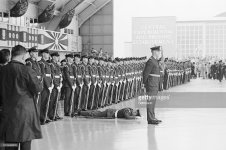Blackadder1916
Army.ca Veteran
- Reaction score
- 2,390
- Points
- 1,160
Came across these two NFB films while looking for something else. While they are not specifically about the Canadian military, it is featured prominently in both.
The Queen in Canada, 1964 https://www.nfb.ca/film/queen_in_canada_1964/
Canada at the Coronation https://www.nfb.ca/film/canada_at_coronation/
The Queen in Canada, 1964 https://www.nfb.ca/film/queen_in_canada_1964/
This short documentary follows Queen Elizabeth and the Duke of Edinburgh as they visit Canada to commemorate the 100th anniversary of Confederation. A hundred years earlier, the Fathers of Confederation had gathered in Charlottetown, Prince Edward Island, to discuss the idea of a united Canada. At a time when Canadians are once again reassessing the nature and role of the diverse communities within Canada, the Queen’s arrival unites onlookers in the idea of Canada as one great nation.
Canada at the Coronation https://www.nfb.ca/film/canada_at_coronation/
This documentary depicts the colour and pageantry of the coronation of Her Majesty Queen Elizabeth II, as well as Canada's participation in this momentous event.


